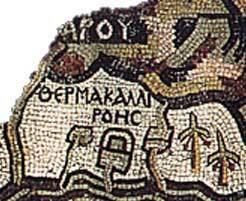Type nymphaeum thermae | Founded 1st century BCE | |
 | ||
Region Eastern shore of Dead Sea, Jordan | ||
Calirrhoe (Ancient Greek: Θερμὰ Καλλιρόης) is an archaeological site in Jordan in which remains of a nymphaeum can be traced, though it is considered difficult to be interpreted. Callirrhoe is known in ancient literature for its thermal springs, because it was visited by King Herodes according to Josephus shortly before his death, as a final attempt to be cured or relief his pains. It remains unknown if the greatest builder in Jewish history is related to any of the observable remains in the area. Callirrhoe is referred in the Midrash as well as by Pliny the Elder (Natural History, 70-72), Ptolemaeus (Geography 15,6) and Solinus (De mirabilibus mundi 35,4).
Contents
Madaba Map
Callirrhoe is represented on Madaba Map. On the mosaic three constructions can be observed, a spring house, a nymphaeum, and a house. Springs' waters are gathered in basins, and two little palm trees are discerned representing the oasis or the fecundity of this area because of the abundant fresh water supply. Waters of the southern spring sprout from the mountain ending up in the sea.
Archaeological surveys
Recently Callirrhoe was identified as the present day oasis Ayn az-Zara, or Ein ez Zara, laying at the eastern shore of Dead Sea, between Wadi Mujib in the south and Wadi Zerka ma'in in the north, being closer to Wadi Zerka ma'in. It was founded circa 1st century BCE and present day excavations were directed by A. Strobel on behalf of the Deutsches Evangelisches Institut für Altertumswissenschaft des Heilingen Landes. The remains are hardly interpretable according to H. Donner. A villa of the 1st century CE, uncovered in recent excavations, is considered to be inspired by the designs used by Herodes for his palaces.
Culture
Callirrhoe is included in the so-called bathing culture, known mainly at Indus Valley Civilization, Ancient Greece, Roman Empire, Middle East and Ottoman Empire, Indonesia and Japan for sanitation, therapy and purification purposes.
